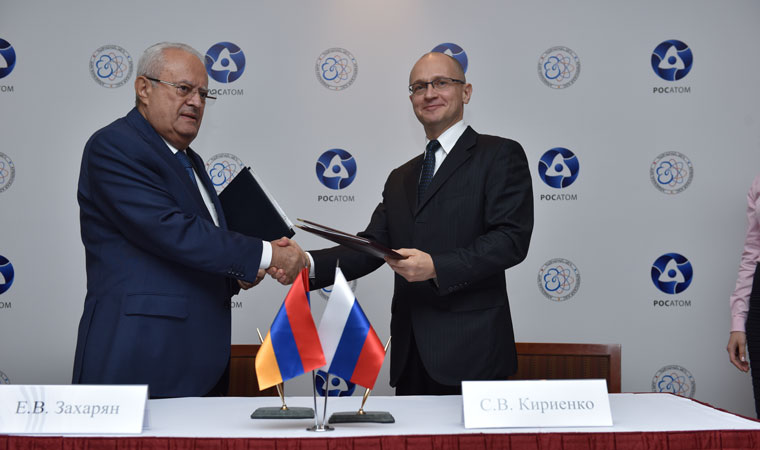
Maintaining stability
back to contentsThe Soviet-built Armenian NPP was designed by Rosatom’s engineering company NIAEP. Its two VVER-440 reactors were used as a model project for Units 3 and 4 of the Novovoronezh and Kola nuclear power plants. Since the Armenian NPP is located in a high seismic area, the project design was adjusted to improve safety of the plant. The design effort involved Atomproekt and four dozens of other R&D institutions. “The nuclear station was initially designed to withstand a 9.5 magnitude earthquake on the Richter scale,” explains Mikhail Anisanyan. Seismic hazards forced engineers to make changes in the design of certain components. In particular, the station was equipped with hydraulic snubbers building a rigid link between the foundation and equipment during an earthquake. Four cooling towers were reinforced to become 30 meters higher than standard 90-meter towers. Furthermore, walls of the reactor building grew by half thicker. Armenian NPP Unit 1 was commissioned in 1976 followed by Unit 2 in 1980.
Target investment
The initial life period of the Armenian NPP was to expire in 2016. Yet in 2013, the Armenian Government decided to keep it operational for 10 more years, till 2026. Following the decision, the nuclear plant was audited by Rosatom, involving more than 100 Russian experts who inspected over 4,500 units of nuclear equipment. As part of the recent visit, Rosatom provided Armenia with 22 provisional audit reports.
Safety inspections at the Armenian NPP were also carried out by the IAEA. “IAEA experts have confirmed that our nuclear power plant is capable of withstanding a strong earthquake and its lifespan can be extended,” says Gera Serikyan, NPP Deputy CEO and the life extension project manager.
To finance the project, Russia will provide a USD 270m loan and a USD 30m grant. The funds will be invested stepwise – first, to inspect systems of Unit 2 and then to agree on the list of equipment to be modernized, replaced or proved as safe. “There is no goal to spend all 300 million dollars. Finance will be provided only for the works approved,” Rosatom CEO Sergei Kirienko explained.
Safety as top priority
“Extension of the service life means that the nuclear station should become much safer than it was right after the construction,” said Sergei Kirienko citing the Kola NPP as an example. After the modernization of Kola Units 3 and 4, their safety was improved nearly 50 times. In addition, Rosatom CEO mentioned an important economic factor in play. “Apart from safety and reliability of the unit, we focus on its economic efficiency as part of our life extension effort. For instance, we are looking for an opportunity to increase capacity of the turbine and improve its capacity utilization factor.” This year’s plans are to prepare a list of long-life equipment to be installed at the modernized unit. “The job is tremendous, and we have to do it as fast as possible to minimize the shutdown time,” said Kirienko. Unit 2 is planned to be brought offline for three months in 2017 and three or four months in 2018. At present, the station generates 380 MW of electric power. After the modernization is completed, it should reach its rated capacity of 440 MW.
Armenia does not rule out another extension after 2026.
“The Government is likely to operate the station for some more years after the 10-year extension period expires,” said Yervand Zakharyan, Armenia’s Minister of Energy and Natural Resources. According to experts, VVER-440 lifespan can be extended for up to 20 years but afterwards the reactor unit has to be decommissioned anyway, and Armenia will face the need for nuclear power development once again.
Local involvement
On 7 October, Yerevan hosted Atomex Armenia, a seminar for nuclear suppliers, organized as part of Rosatom’s visit to the country. Evgeny Salkov, Rusatom Service CEO, spoke about the current status of the Unit 2 life extension project and potential involvement of Armenian companies. “The primary task of project stakeholders is to improve safety of the reactor unit. This is what we are aiming at.”
The project will be implemented in two stages. Already in progress, the first stage includes due diligence and life extension program development. The program will be implemented during the second project stage, which will comprise research and development, analysis, design, construction, installation and commissioning of the unit.
The project is scheduled for completion in 2019. “We are ahead of the schedule now, but we have set an ambitious goal to complete the project within five years,” says Evgeny Salkov. “This is not an easy task and we will do our best to meet the deadline.”
Twelve companies are already involved in due diligence, among them OKB Gidropress and NIAEP (Nizhny Novgorod) responsible for the project design. Dozens of other suppliers will take part in the project, too. The most active of them presented their products at the seminar. Much interest was aroused by basalt nuclear waste repositories. The project provides for the delivery of concrete slabs, but the offer made by the local supplier seemed to be more feasible. “If certified, this will be the best economic solution for the power plant,” Evgeny Salkov approved the proposal.
Another document signed by Russia and Armenia on 7 October in Yerevan was an intergovernmental agreement on exchange of nuclear and radiation safety information. The agreement sets a framework for emergency notifications in the civil nuclear field.




